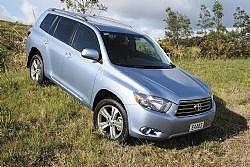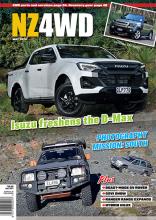Toyota’s Highlander is a particularly significant model in the Japanese carmaker’s arsenal, since it represents the first in a new series of 4WDs. Although essentially a “soft-roader” – meaning it doesn’t have a low ratio transfer box – it offers the opportunity to get out and about into wilder country by virtue of its permanent 4WD system coupled with traction control, plus a hill descent system. Although a completely new design, this latest Highlander owes a lot to the RAV4 in terms of its overall look and feel, with sharply defined lines, a powerful grille, and large headlamps. From the side its length – it’s a full seven seater - is accentuated by the roof rails and large windows, plus wheel arch “blisters”, while at the back there’s a large rear window and big tail lights. In addition the big lift-up tailgate has an independently opening glass hatch which allows luggage to be loaded and unloaded without opening the main tailgate. The glass hatch can be unlocked separately from the door using the wireless remote. Overall dimensions of the new Highlander have increased – it’s 17 mm taller, 95 mm longer, 85 mm wider and has a 75 mm longer wheelbase. On the Limited model, as tested, there are also body coloured electric exterior rear view mirrors as well as front fog lights, halogen headlights with a smoked finish, a chrome-plated front grille and a large roof mounted rear spoiler. Gone is the bland styling of the previous version – this car makes a bold statement, and was in fact designed at Toyota’s Calty studio in California. The previous model, introduced seven years ago, was built off the old Camry platform that had served the company so well. The latest version also comes off a car platform – this time the latest Avalon – and as such combines a degree of ruggedness with really good on-road ability and super ride qualities. And it also gets the latest 3.5-litre V6 engine as used in the Aurion, a 201 kW unit that’s as smooth as they come and delivers all the power and torque most people will want. More importantly these days, that new-found power, not to mention the extra weight that the new vehicle carries, does not impact on fuel economy at all - in fact, the new Highlander uses less petrol than the previous model. The new engine connects to a smooth electronically-controlled 5-speed automatic transmission with sequential manual mode. Uphill and downhill shift control minimises gear changes when driving on windy and hilly roads. This is a really neat feature. Based on inputs such as throttle opening and vehicle speed, the system determines whether the vehicle is travelling uphill or downhill. When travelling uphill, the system prevents unnecessary upshifts, limiting the “hunting” that sometimes occurs in an automatic on hilly terrain. Even better, and especially off-road, the system offers engine braking by automatically downshifting. The Highlander gets a full-time 4WD system operating with a 50:50 split front-rear at all times. However, there’s no locking centre differential; instead the vehicle relies on traction control to overcome lost motion due to a spinning wheel. What happens is that the traction control locks the spinning wheel by applying the brakes on that wheel alone, ensuring torque is transferred to a wheel or wheels which have grip. In addition the power steering now uses an electric motor mounted on the steering column for power assist, which eliminates all the pumps, hoses, belts and power steering fluid of the old type system and greatly improves reliability. As with all new Toyota models the Highlander is significantly quieter, due to things such as new sound deadening, seals around the entire bonnet, and foam filler in many body cavities. Noises entering the interior are further controlled by resculpting the outside mirrors for better airflow and making the body more aerodynamic, even down to the underbody surfaces. Inside the Highlander definitely moves more upmarket than its predecessor, and there’s a lot more room inside the cabin. There’s a new instrument panel which is a lot more European in its design and function, and a lot less bland than we’ve come to expect from Toyota. At the same time Toyota hasn’t fallen into the trap of making it overly complex, and all controls are arranged to minimise confusion and make everything intuitive and easy to use, and with large knobs that are easy to use. The dash panel is smooth and flowing, especially in front of the passenger where an invisible type passenger airbag is adopted, with no parting line. The Optitron instruments are grouped right in front of the driver in a deeply-dished display that ensures extraneous light isn’t going to prevent them being seen. At the same time the dials – there’s a revcounter on the left and speedo on the right, flanking fuel and water temperature gauges – are brightened with chrome trim work. There’s also chrome plating on the openings of the front console cup holders and audio knob rings, enhancing the feeling of quality, and a silver finish on the centre console and upper console area, as well as trim panels on the leather-rimmed steering wheel. The wheel also has remote controls for the audio system and the multi information display as well as – and this is something we’ve not seen before – the air conditioning and heating, this latter featuring front and rear climate control with independent left and right. The leather-covered seats are extremely comfortable, with additional leg support adjustment and power lumbar support for the driver. Both front seats have seat heaters and electric adjustment. An interesting feature on the second row of seats is that it can be converted from a three-seater into two individual “captain’s chairs” by removing the centre section and replacing it with a between-seats console, or even leaving out the console altogether to allow “walk-through” to the back. The part not being used is stowed between the front seats in its own compartment. At the same time this second row can be made extra-comfortable thanks to seat tracks that allow it to be adjusted back and forth to allow more room, if needed, for third row passengers. The third row seat is a two-person bench that can easily be folded into the floor with remote levers near the tailgate, as can the centre row, leaving a huge flat area for loading when there are just two people aboard. However, the third row doesn’t give as much room as, for instance, the Ford Territory or Land Rover Discovery 3 – it’s an occasional seat for adults, who sit a bit “knees-up”, or for children. Talking of which, there’s also a handy drop-down mirror in the overhead console to give parents the equivalent of eyes in the back of their heads! And still on the subject of children – well, partly – there’s a rearview camera which displays on a small screen at the top of the dash when reverse is engaged. It gives a lovely wide view since the camera is mounted just above the number plate. The camera is tiny and unlikely to get damaged in that position, though it might get covered in road dirt or mud when using the vehicle off-road. When not being used for the camera the display is used for the clock, warning messages and trip computer. Cruise information shows average fuel consumption, instant fuel consumption, current, average and total average fuel consumption, driving range, and total driving distance. Naturally safety standards are high, and the Highlander gets dual stage front airbags for driver and front passenger seats as well as a knee airbag for the driver’s seat, front side airbags and roll-sensing side curtain airbags for all three rows in addition to active headrests for the driver and front passenger that include active whiplash protection, There’s also a full contingent of “alphabet soup” features, with ABS brakes with Electronic Brake-force Distribution (EBD) and Brake Assist (BA), Traction Control (TRC), Vehicle Stability Control Plus (VSC+), Hill start Assist Control (HAC) and Downhill Assist Control (DAC). Suspension is MacPherson strut at the front and dual link strut at the back, and Limited models get 19 inch five-spoke alloy wheels shod with 245/55 rubber. The Highlander is a comfortable cruiser, and driving off-road proved it has more than enough power to forge up steep hills. The extra power is also a boon for those who want to use the Highlander for towing, and there’s a really neat removable tow hitch available from Toyota parts and accessories. On the tarmac that modern platform gives great handling and an excellent ride, especially for a 4WD. And its off-road ability is quite remarkable for this type of soft-roader. Ground clearance isn’t great, but at 206 mm as good as if not better than most of its competitors. The auto ‘box in some part compensates for the lack of a low ratio in ordinary conditions, except when going down steep hills, which is where the downhill assist feature comes in, and the sequential shift-matic transmission enables manual shifting. There’s also a “Snow” setting which is great on slippery stuff since it uses higher gears to prevent wheelspin. More importantly, there’s an “off” button for the VSC so you can get a bit of wheelspin when you need it without the system cutting power. Another good feature is that uphill start system, which holds the car on the brakes for one second to enable the vehicle to pull away without slipping backwards. All-in-all, a nice package which we enjoyed immensely. Although nowhere near being an out-and-out off-roader, it has enough 4WD ability to enable most people to enjoy the outdoors safely and in comfort, while providing a huge degree of versatility and space. If there’s a fault, it’s that Toyota doesn’t offer a diesel version..
Toyota Highlander
Tuesday, 30 October 2007



